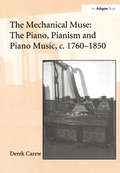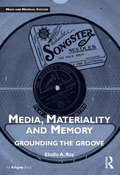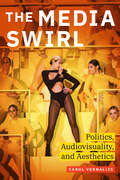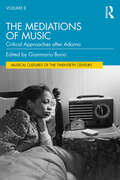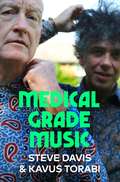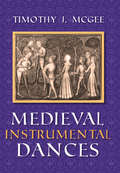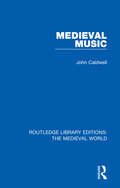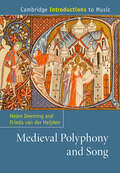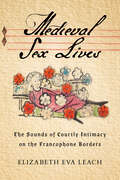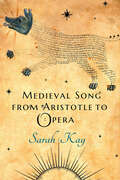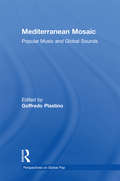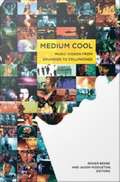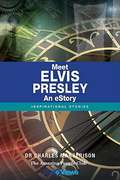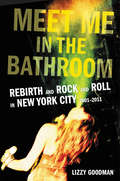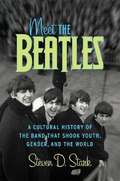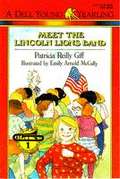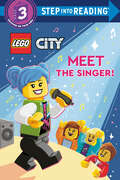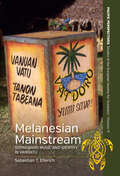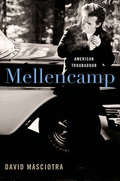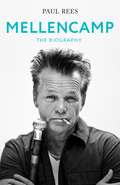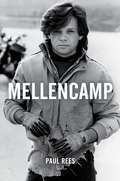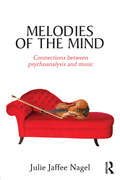- Table View
- List View
The Mechanical Muse: The Piano, Pianism and Piano Music, c.1760-1850
by Derek CarewThis book charts the piano's accession from musical curiosity to cultural icon, examining the instrument itself in its various guises as well as the music written for it. Both the piano and piano music were very much the product of the intellectual, cultural and social environments of the period and both were subject to many influences, directly and indirectly. These included character (individualism), the vernacular ('folk/popular') and creativity (improvisation), all of which are discussed generally and with respect to the music itself. Derek Carew surveys the most important pianistic genres of the period (variations, rondos, and so on), showing how these changed from their received forms into vehicles of Romantic expressiveness. The piano is also looked at in its role as an accompanying instrument. The Mechanical Muse will be of interest to anyone who loves the piano or the period, from the non-specialist to the music postgraduate.
Media, Materiality and Memory: Grounding the Groove (Music and Material Culture)
by Elodie A. RoyMedia, Materiality and Memory: Grounding the Groove examines the entwinement of material music objects, technology and memory in relation to a range of independent record labels, including Sarah Records, Ghost Box and Finders Keepers. Moving from Edison’s phonograph to digital music files, from record collections to online archives, Roy argues that materiality plays a crucial role in constructing and understanding the territory of recorded sound. How do musical objects ‘write’ cultural narratives? How can we unearth and reactivate past histories by looking at yesterday’s media formats? What is the nature, and fate, of the physical archive in an increasingly dematerialized world? In what ways do physical and digital musical objects coexist and intersect? With its innovative theoretical approach, the book explores the implications of materialization in the fashioning of a musical world and its cultural transmission. A substantial contribution to the field of music and material culture studies, Media, Materiality and Memory also provides a nuanced and timely reflection on nostalgia and forgetting in the digital age.
The Media Swirl: Politics, Audiovisuality, and Aesthetics
by Carol VernallisFrom fan-generated content on TikTok to music videos, the contemporary media landscape is becoming ever more vast, spectacular, and intense. In The Media Swirl Carol Vernallis examines short-form audiovisual media—Beyoncé’s Lemonade, brief sequences from Baz Luhrmann’s The Great Gatsby, TikTok challenges, YouTube mashups, commercials, and many other examples—to offer ways of understanding digital media. She analyzes music videos by Beyoncé, Lady Gaga, Janelle Monáe, Kendrick Lamar, Anderson .Paak, and others to outline how sound and image enhance each other and shape a viewer’s mood. Responding to today’s political-media landscape through discussions of Fox News and Presidential inaugurations, Vernallis shows how a media literacy that exceeds newscasts and campaign advertising is central to engaging with the democratic commons. Forays into industry studies, neuroscience, and ethics also inform her readings. By creating our own content and knowing what corporations, the wealthy, and the government do through media, Vernallis contends, we can create a more just world.
The Mediations of Music: Critical Approaches after Adorno (Musical Cultures of the Twentieth Century)
by Gianmario BorioAdorno believed that a circular relationship was established between immediacy and mediation. Should we now say that this model with its clear Hegelian influence is outdated? Or does it need some theoretical integration? This volume addresses these questions by covering the performance of music, its technological reproduction and its modes of communication – in particular, pedagogy and dissemination through the media. Each of the book’s four parts deal with different aspects of the mediation process. The contributing authors outline the problematic moments in Adorno’s reasoning but also highlight its potential. In many chapters the pole of immediacy is explicitly brought into play, its different manifestations often proving to be fundamental for the understanding of mediation processes. The prime reference sources are Adorno’s Current of Music, Towards a Theory of Musical Reproduction and Composing for the Films. Critical readings of these texts are supplemented by reflections on performance studies, media theories, sociology of listening, post-structuralism and other contiguous research fields.
Medical Grade Music
by Steve Davis Kavus TorabiThe story of two outsiders and obsessives whose collision prompted an evangelistic alliance on the furthest frontiers of underground music.Steve Davis first met Kavus Torabi - guitarist with Gong, Guapo, Cardiacs and Knifeworld - in the mid-2000's at a gig by French underground rock legends Magma. Over the next few years, this unlikely duo's shared affinity for visionary psychedelic music would become the foundation of not only a firm friendship, but also the most infectiously inclusive broadcasting style since the much-mourned death of John Peel. In their weekly radio shows and a one-of-a-kind live DJ roadshow which included a legendary appearance at Glastonbury, Steve and Kavus mapped out a musical landscape of rare enchantment, where the only passport needed was a pair of open ears. No-one, least of all Davis and Torabi themselves, was expecting the 6-time former World Snooker champion and a British-Iranian underground rock musician to become one of the most trusted brands in British alternative music.As Steve and Kavus were starting to get to grips with the challenge of their newfound status, events took a further unexpected turn. Suddenly they found themselves in a band together. And not just any band ... as two thirds of Britain's (if not the world's) leading harmonium, guitar and analogue synth power-trio (with Michael J.York of Coil)The Utopia Strong, the two friends found themselves plunging into a vortex of spontaneous compositional excitement. How Steve and Kavus pulled this off is just one of the many questions MEDICAL GRADE MUSIC will try to answer. Part sonic memoir, part Socratic dialogue, part gonzo mission to the heart of what makes music truly psychedelic this book is the first work of joint autobiography to ever trace the evolution of a life-changing friendship through the discographies of Gentle Giant and Voivod. From the chip-shops of Plumstead to the the wildest shores of Plymouth's nineties thrash scene. it's a funny and fearless buddy movie of the soul, with a soundtrack that will make your eyes bleed.
Medieval Instrumental Dances
by Timothy J. McgeeIn Europe the tradition of secular dance has continued unbroken until the present. In the late Middle Ages it was an important and frequent event--for the nobility a gracious way to entertain guests, for the peasantry a welcome relaxation from the toils of the day. Now back in print, this collection presents compositions that are known or suspected to be instrumental dances from before ca. 1420. The forty-seven pieces vary in length and style and come from French, Italian, English, and Czech sources. Timothy McGee relates medieval dances to the descriptions found in literary, theoretical, and archival sources and to the depictions in the iconography of the Middle Ages. In a section on instrumental performance practices, he provides information about ornamenting the dances and improvising in a historically appropriate style. This comprehensive edition brings together in one volume a repertory that has been scattered over many years and countries.
Medieval Music (Routledge Library Editions: The Medieval World #8)
by John CaldwellOriginally published in 1978, Medieval Music explores the fascinating development of medieval western music from its often obscure origins in the Jewish synagogue and early Church, to the mid-fifteenth century. The book is intended as a straightforward survey of medieval music and emphases the technical aspects such as form, style and notation. It is illustrated by nearly one hundred musical examples, the majority of which have been transcribed from original sources and many of which contains chapters on Latin chant and other forms of sacred monophony, secular song, early polyphony, the ars antiqua, French and Italian fourteenth-century music, English music, and fifteenth-century music. Each chapter is followed by a classified bibliography divided into musical sources, literary sources and modern studies; in addition to a comprehensive bibliography.
Medieval Music, Legend, and the Cult of St. Martin
by Yossi MaureySt Martin of Tours was a protector saint of numerous French kings. His was one of the most successful saintly cults in medieval Europe, and the city of Tours functioned as a religious metropolis, drawing pilgrims from all over the continent. Until now, little has been known about how St Martin came to inspire such a lively folkloric tradition, numerous works of art, and the establishment of thousands of churches and numerous confraternities. In this book, Yossi Maurey addresses these questions by focusing on the church dedicated to the saint in Tours, which acted as the crucible for Martin's cult. Maurey explores the music and liturgy of the cult - the most effective means of its dissemination - to reveal its enormous diffusion and impact. Building a more concrete picture of how saints' cults operated and shaped medieval realities, this book also provides new insights into the interactions between contemporary religion, art and politics.
Medieval Polyphony and Song (Cambridge Introductions to Music)
by Helen Deeming Frieda van der HeijdenWhat characterises medieval polyphony and song? Who composed this music, sang it, and wrote it down? Where and when did the different genres originate, and under what circumstances were they created and performed? This book gives a comprehensive introduction to the rich variety of polyphonic practices and song traditions during the Middle Ages. It explores song from across Europe, in Latin and vernacular languages (precursors to modern Dutch, English, French, German, Italian, Portuguese and Spanish); and polyphony from early improvised organum to rhythmically and harmonically complex late medieval motets. Each chapter focuses on a particular geographical location, setting out the specific local contexts of the music created there. Guiding the reader through the musical techniques of melody, harmony, rhythm, and notation that distinguish the different genres of polyphony and song, the authors also consider the factors that make modern performances of this music sound so different from one another.
Medieval Sex Lives: The Sounds of Courtly Intimacy on the Francophone Borders
by Elizabeth Eva LeachMedieval Sex Lives examines courtly song as a complex cultural product and social force in the early fourteenth century, exploring how it illuminates the relationship between artistic production and the everyday lives of the elites for whom this music and poetry was composed and performed. In a focused analysis of the Oxford Bodelian Library's Douce 308 manuscript—a fourteenth-century compilation that includes over five hundred Old French lyrics composed over two centuries alongside a narrative account of elaborate courtly festivities centered on a week-long tournament—Elizabeth Eva Leach explores two distinct but related lines of inquiry: first, why the lyric tradition of "courtly love" had such a long and successful history in Western European culture; and, second, why the songs in the Bodleian manuscript would have been so important to the book's compilers, owners, and readers. The manuscript's lack of musical notation and authorial attributions make it unusual among Old French songbooks; its arrangement of the lyrics by genre invites inquiry into the relationship between this long musical tradition and the emotional and sexual lives of its readers. Combining an original account of the manuscript's contents and their likely social milieu with in-depth musical and poetic analyses, Leach proposes that lyrics, whether read or heard aloud, provided a fertile means of propagating and enabling various sexual scripts in the Middle Ages. Drawing on musicology, literary history, and the sociology and psychology of sexuality, Medieval Sex Lives presents a provocative hypothesis about the power of courtly songs to model, inspire, and support sexual behaviors and fantasies.
Medieval Song from Aristotle to Opera
by Sarah KayFocusing on songs by the troubadours and trouvères from the twelfth to the fourteenth centuries, Medieval Song from Aristotle to Opera contends that song is not best analyzed as "words plus music" but rather as a distinctive way of sounding words. Rather than situating them in their immediate period, Sarah Kay fruitfully listens for and traces crosscurrents between medieval French and Occitan songs and both earlier poetry and much later opera. Reflecting on a song's songlike quality—as, for example, the sound of light in the dawn sky, as breathed by beasts, as sirenlike in its perils—Kay reimagines the diversity of songs from this period, which include inset lyrics in medieval French narratives and the works of Guillaume de Machaut, as works that are as much desired and imagined as they are actually sung and heard. Kay understands song in terms of breath, the constellations, the animal soul, and life itself. Her method also draws inspiration from opera, especially those that inventively recreate medieval song, arguing for a perspective on the manuscripts that transmit medieval song as instances of multimedia, quasi-operatic performances. Medieval Song from Aristotle to Opera features a companion website (cornellpress.manifoldapp.org/projects/medieval-song) hosting twenty-four audio or video recordings, realized by professional musicians specializing in early music, of pieces discussed in the book, together with performance scores, performance reflections, and translations of all recorded texts. These audiovisual materials represent an extension in practice of the research aims of the book—to better understand the sung dimension of medieval song.
Medievalism and Nationalism in German Opera: Euryanthe to Lohengrin (Routledge Research in Music)
by Michael S. RichardsonMedievalism, or the reception or interpretation of the Middle Ages, was a prominent aesthetic for German opera composers in the first half of the nineteenth century. A healthy competition to establish a Germanic operatic repertory arose at this time, and fascination with medieval times served a critical role in shaping the desire for a unified national and cultural identity. Using operas by Weber, Schubert, Marshner, Wagner, and Schumann as case studies, Richardson investigates what historical information was available to German composers in their recreations of medieval music, and whether or not such information had any demonstrable effect on their compositions. The significant role that nationalism played in the choice of medieval subject matter for opera is also examined, along with how audiences and critics responded to the medieval milieu of these works. In this book, readers will gain a clear understanding of the rise of German opera in the early nineteenth century and the cultural and historical context in which this occurred. This book will also provide insight on the reception of medieval history and medieval music in nineteenth-century Germany, and will demonstrate how medievalism and nationalism were mutually reinforcing phenomena at this time and place in history.
Mediterranean Mosaic: Popular Music and Global Sounds
by Goffredo PlastinoFirst published in 2003. Routledge is an imprint of Taylor & Francis, an informa company.
Medium Cool: Music Videos from Soundies to Cellphones
by Roger Beebe Jason MiddletonMusic videos are available on more channels, in more formats, and in more countries than ever before. While MTV--the network that introduced music video to most viewers--is moving away from music video programming, other media developments signal the longevity and dynamism of the form. Among these are the proliferation of niche-based cable and satellite channels, the globalization of music video production and programming, and the availability of videos not just on television but also via cell phones, DVDs, enhanced CDs, PDAs, and the Internet. In the context of this transformed media landscape, Medium Cool showcases a new generation of scholarship on music video. Scholars of film, media, and music revisit and revise existing research as they provide historically and theoretically expansive new perspectives on music video as a cultural form. The essays take on a range of topics, including questions of authenticity, the tension between high-art influences and mass-cultural appeal, the prehistory of music video, and the production and dissemination of music videos outside the United States. Among the thirteen essays are a consideration of how the rapper Jay-Z uses music video as the primary site for performing, solidifying, and discarding his various personas; an examination of the recent emergence of indigenous music video production in Papua New Guinea; and an analysis of the cultural issues being negotiated within Finland's developing music video industry. Contributors explore precursors to contemporary music videos, including 1950s music television programs such as American Bandstand, Elvis's internationally broadcast 1973 Aloha from Hawaii concert, and different types of short musical films that could be viewed in "musical jukeboxes" of the 1940s and 1960s. Whether theorizing music video in connection to postmodernism or rethinking the relation between sound and the visual image, the essays in Medium Cool reveal music video as rich terrain for further scholarly investigation. Contributors. Roger Beebe, Norma Coates, Kay Dickinson, Cynthia Fuchs, Philip Hayward, Amy Herzog, Antti-Ville Krj, Melissa McCartney, Jason Middleton, Lisa Parks, Kip Pegley, Maureen Turim, Carol Vernallis, Warren Zanes
Meet Elvis Presley - An eStory
by Charles MargerisonMeet Elvis Presley, a cultural icon all over the world and one of the most famous singers of the 20th century. You may know and love many of his songs and movies, but how much do you know about his real life? In this unique audio story from The Amazing People Club, gain new insight on the real life of the "The King" and follow him from the two-room shotgun house in Tupelo where he was born to the time he first walked into Sun Records in Memphis, which changed his life. Gain a fascinating insight on Elvis' life and better understand the man behind the legend through BioViews®.A BioView® is a short biographical story, similar to an interview. These unique audio stories provide an easy way of learning about amazing people who made major contributions to our world.
Meet Me in the Bathroom: Rebirth and Rock and Roll in New York City 2001-2011
by Lizzy GoodmanJoining the ranks of the classics Please Kill Me, Our Band Could Be Your Life, and Can’t Stop Won’t Stop, an intriguing oral history of the post-9/11 decline of the old-guard music industry and rebirth of the New York rock scene, led by a group of iconoclastic rock bands.In the second half of the twentieth-century New York was the source of new sounds, including the Greenwich Village folk scene, punk and new wave, and hip-hop. But as the end of the millennium neared, cutting-edge bands began emerging from Seattle, Austin, and London, pushing New York further from the epicenter. The behemoth music industry, too, found itself in free fall, under siege from technology. Then 9/11/2001 plunged the country into a state of uncertainty and war—and a dozen New York City bands that had been honing their sound and style in relative obscurity suddenly became symbols of glamour for a young, web-savvy, forward-looking generation in need of an anthem.Meet Me in the Bathroom charts the transformation of the New York music scene in the first decade of the 2000s, the bands behind it—including The Strokes, The Yeah Yeah Yeahs, LCD Soundsystem, Interpol, and Vampire Weekend—and the cultural forces that shaped it, from the Internet to a booming real estate market that forced artists out of the Lower East Side to Williamsburg. Drawing on 200 original interviews with James Murphy, Julian Casablancas, Karen O, Ezra Koenig, and many others musicians, artists, journalists, bloggers, photographers, managers, music executives, groupies, models, movie stars, and DJs who lived through this explosive time, journalist Lizzy Goodman offers a fascinating portrait of a time and a place that gave birth to a new era in modern rock-and-roll.
Meet the Beatles: A Cultural History of the Band That Shook Youth, Gender, and the World
by Steven D. StarkA discussion of the trends that created and followed the Beatles, tales of each members childhood,how their style represents mild gender bending, and attempts to describe their many long term impacts.
Meet the Lincoln Lions Band
by Patricia Reilly GiffPa-dum. Pa-dum. Pa-dum. There's going to be a marching band at the Lincoln School! Drums...fifes...new uniforms...parades! Chrissie Tripp is going to sign right up. She just knows she'll make a great band kid. She's so sure, she tells her new friend, Michelle, she's already in the band. But then, gonzo! The president of the school, who just happens to be Chrissie's big-mouth sister, Theresa, makes a horrible announcement about the Lincoln Lions Band. If Chrissie doesn't do something fast, she's going to look like a liar--a big liar. Chrissie's new school year is off to a bad start. She cuts through the neighbor's yard, she sneaks in to school when she's not allowed, the teacher makes her sit in the trouble-maker's seat, she draws an ugly picture of her teacher, makes up nasty names for the new kids, lies about being in the band, breaks her sister's birthday present, gets in a big fight, and does more things she shouldn't. What she really wants is to be in the band, to do something important and to make friends and be happy in school. You'll love reading about this girl who is like lots of kids you know.
Meet the Orchestra
by Ann HayesThis lyrical romp through the orchestra begins with animal musicians slowly gathering for the evening performance. Poetic descriptions suggest the sounds of the instruments, and lively watercolor illustrations capture the playful essence of each musician and musical instrument. "It’s a smashing introduction to classical music, and a must prior to a first visit to the symphony. ”--Publishers Weekly
Meet the Singer! (Step into Reading)
by Steve FoxeLEGO© City fans will love this new MEET THE…LEGO City Step into Reading leveled reader series, featuring exciting careers including an astronaut, a singer, a firefighter, and more!Children ages 4 to 8, will love reading about Madison and Billy as they interview singing sensation Poppy Starr in this Step 3 Step into Reading leveled reader!Step 3 readers feature engaging characters in easy-to-follow plots about popular topics. For children who are ready to read on their own.LEGO, the LEGO logo, the Brick and Knob configurations and the Minifigure are trademarks of the LEGO Group.
Melanesian Mainstream: Stringband Music and Identity in Vanuatu (Pacific Perspectives: Studies of the European Society for Oceanists #11)
by Sebastian EllerichCitizens of Vanuatu (ni-Vanuatu) perceive stringband music as a marker of national identity, an indicator of their cultural, stylistic, and musical heritage. Through extensive field and ethnographic research, Melanesian Mainstream offers a detailed historical record of the roots, context, evolution, and impact of stringband music. Beyond chronicling the genre’s history and cultural significance, this thorough monograph positions the genre’s musical hybridity, communal lyrics, and unique organizational structures as key factors in the anthropological understanding of ni-Vanuatu socio-cultural history.
Mellencamp: American Troubadour
by David MasciotraThroughout his prolific career, John Mellencamp has performed more than twenty Top 40 hits, has been nominated for thirteen Grammy Awards, and has been inducted into the Rock and Roll Hall of Fame. Hits like "Jack and Diane," "Small Town," and "Cherry Bomb" are iconic American songs that have played an important role in defining midwestern music and developing the rock genre. Despite his critical and commercial success, however, the rough guy from a small town writing songs about everything he "learned about living" is often omitted from the ranks of America's songwriting elite.In Mellencamp, David Masciotra explores the life and career of one of America's most important and underrated songwriters, persuasively arguing that he deserves to be celebrated alongside artists like Bruce Springsteen, Neil Young, and Bob Dylan. Beginning with his modest beginnings in Seymour, Indiana, Masciotra details Mellencamp's road to fame, examining his struggles with the music industry and his persistent dedication to his midwestern roots. Shaking off the shortsighted "regionalist" stereotype and dismissing his assumed pop-star persona, Mellencamp found success by remaining true to where he came from.This thoughtful analysis highlights four decades of the artist's music, which has consistently elevated the dignity of everyday people and honored the quiet heroism of raising families and working hard. This first serious biography of the legendary musician will charm fans and music enthusiasts who are interested in the development of roots rock and Americana music.
Mellencamp: The Biography
by Paul ReesThe definitive biography of John Mellencamp featuring exclusive interviews and never-before-told details about the life of the iconic American rock and roll original.John Mellencamp is not your typical rock star.With music inspired by the work of William Faulkner, John Steinbeck, and other giants of American literature, Mellencamp is a complex, colorful and larger than life character who walks to the beat of his own drum. Or, as he told author and veteran music journalist, Paul Rees: 'I just refuse to take shit off anyone'. Now, this fascinating biography fully charts the life of one of this country's most important voices in American music.Mellencamp's story is also the story of the American heartland. His coming of age as an artist and evolution into legendary status directly reflected the major changes of the last fifty years. From the Summer of Love to the growing divisiveness of American politics and beyond, his music has served as the backdrop of this evolving country for millions of fans.For the first time, this story written with the cooperation and support of Mellencamp and his management will include extensive interviews with members of Mellencamp's family, many of his bandmates and collaborators, past and present, and Mellencamp himself. Together, they shed new light on a man hailed by none other than Johnny Cash as 'among our greatest living songwriters'. An exploration of everything from the founding of Farm Aid to his induction into the Rock and Roll Hall of Fame, this is a fresh and expansive look at a true original.
Mellencamp
by Paul ReesThe definitive biography of John Mellencamp, the iconic American rock and roll original, featuring exclusive in-depth interviews and never-before-told details. Perfect for fans of Janis and Born to Run.John Mellencamp is not your typical rock star. With music inspired by the work of William Faulkner, John Steinbeck, and other giants of American literature, he has experienced a colorful career unlike any other. Now, this fascinating biography fully charts the life of one of this country&’s most important voices in American music. Mellencamp&’s story is also the story of the American heartland. His coming of age as an artist and evolution into legendary status directly reflected the major changes of the last fifty years. From the Summer of Love to the growing divisiveness of American politics and beyond, his music has served as the backdrop to this evolving country for millions of fans. Featuring exclusive interviews with friends, family, and colleagues, and exploring everything from the founding of Farm Aid to his induction into the Rock and Roll Hall of Fame, this is a fresh and expansive look at a true original.
Melodies of the Mind: Connections between psychoanalysis and music
by Julie Jaffee NagelWhat can psychoanalysis learn from music? What can music learn from psychoanalysis? Can the analysis of music itself provide a primary source of psychological data? Drawing on Freud's concept of the oral road to the unconscious, Melodies of the Mind invites the reader to take a journey on an aural and oral road that explores both music and emotion, and their links to the unconscious. In this book, Julie Jaffee Nagel discusses how musical and psychoanalytic concepts inform each other, showing the ways that music itself provides an exceptional non-verbal pathway to emotion – a source of 'quasi' psychoanalytical clinical data. The interdisciplinary synthesis of music and psychoanalytic knowledge provides a schema for understanding the complexity of an individual's inner world as that world interacts with social 'reality'. There are three main areas explored: The Aural Road Moods and Melodies The Aural/Oral Road Less Travelled Melodies of the Mind is an exploration of the power of music to move us when words fall short. It suggests the value of using music and ideas of the mind to better understand and address psychological, social, and educational issues that are relevant in everyday life. It will be of interest to psychoanalysts, psychologists, music therapists, musicians, music teachers, music students, social workers, educators, professionals in the humanities and social services as well as music lovers. Julie Jaffee Nagel is a graduate of The Juilliard School, The University of Michigan, and The Michigan Psychoanalytic Institute. She is on the faculty of the Michigan Psychoanalytic Institute and is in private practice in Ann Arbor, Michigan.
